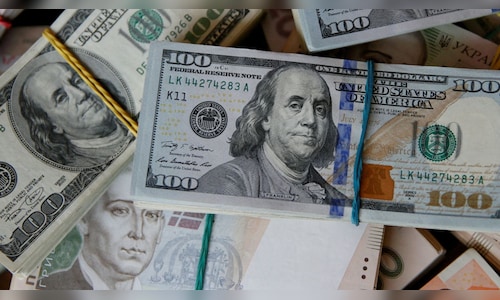Firms are receiving more requests for transactions including hedges that sidestep the dollar and involve currencies such as the yuan, the Hong Kong dollar, the Emirati dirham and the euro. There’s also demand for yuan-denominated loans, and a bank in Indonesia is setting up a desk for the Chinese currency.
The vast majority of foreign-exchange trades use the dollar even if they’re transferring money between two local currencies. For example, an Egyptian company wanting Philippine pesos will typically transfer its local currency into the greenback before buying pesos with the dollars it receives. But companies are increasingly looking at strategies that skip the dollar’s role as a go-between.
The attempt to find alternatives is another sign that companies and investors are turning their backs on the world’s reserve currency, which was hit with a wave of selling this week amid shifting bets on trade deals. Stephen Jen, a high-profile strategist known for his work on the “dollar smile” theory, has warned of a potential $2.5 trillion “avalanche” of dollar selling that could derail the currency’s long-term appeal.
The greenback’s tumble this week reflected short-term anxieties about trade tensions that are now dominating sentiment. But structural changes in how the greenback is used — and by whom — point to a longer-term trend of de-dollarization.
“The increase in transactions between non-US currencies is largely due to technological development and increased liquidity,” said Gene Ma, head of China research at the Institute of International Finance. “The trading parties feel that the price may not be worse than using the US dollar, so transactions naturally pick up.”
Peak Dollar
The attempt to bypass the dollar is picking up steam, based on conversations with employees of companies and financial institutions across Asia, who asked not to be identified as they aren’t allowed to comment publicly.
Financial institutions from Europe and elsewhere are increasingly pitching yuan derivatives that cut out the US currency, said a person at a commodities trading firm in Singapore. Closer commercial ties between mainland China, Indonesia and the Gulf are spurring demand for non-dollar hedges, several people said.
Read Also: Taiwan’s exports surge to record, fueling currency gains
European carmakers are driving up demand for euro-yuan hedges, said a trader at a financial institution in Singapore. In Indonesia, a foreign bank is due to set up a dedicated team in Jakarta this year to meet growing demand from local clients to facilitate rupiah-yuan transactions, according to an executive at the firm.
The gradual shift away from the dollar erodes one of the building blocks of global trade. For decades, it has been ubiquitous in everything from emerging market debt financing to trade settlement. The use of the dollar as a go-between currency accounts for around 13% of its daily trading volumes, according to a recent estimate.
But global use of the dollar was under threat even before US President Donald Trump’s unpredictable approach to trade forced a radical rethink about the greenback’s place in the world.
China has for years been trying to promote international use of its own currency, signing currency settlement agreements with Brazil, Indonesia and others and promoting the global use of the yuan. The BRICS group of emerging-market nations has discussed de-dollarization. Russia’s invasion of Ukraine in 2022 spurred interest among some countries in shifting away from the dollar, after sanctions on Moscow raised questions about whether the currency had become weaponised.
To be sure, few market participants doubt that a move away from the dollar will be anything but a gradual shift. For one thing, there are no realistic candidates to replace it. The use of the euro in global transactions has fallen over the past two years, according to data from global payments company Swift, while China’s currency remains a novelty for trade not directly involving the world’s second-largest economy.
China’s Trade Anchor
China’s yuan was used in around 4.1% of global payments in March, according to data from global payments company Swift, a far cry from the dollar’s 49% global use. But some of China’s payments are being done through its own system, which is growing rapidly.
Annual volumes through the Cross-Border Interbank Payment System reached around 175 trillion yuan ($24 billion) in 2024, a more than 40% year-on-year growth rate, according to its own data.
Chinese investors and trading companies used the yuan in a record percentage of their cross-border activities in March. The country’s exporters are also speeding up the exchange of dollars into yuan, reversing a previous trend of exporters sitting on dollar revenues amid fears the yuan would weaken.
Chinese exports to Southeast Asia have grown more than 80% in the five years to March 2025, while those to the United Arab Emirates and Saudi Arabia more than doubled, according to Bloomberg-compiled data. That far exceeds the rate of growth for the country’s exports to the US and the European Union.
While yuan-based hedges are often more expensive than those based on the dollar, low interest rates on underlying yuan loans can mean the total cost is still attractive for borrowers.
“You can fund yourself at a third of the cost that you would fund yourself in dollars,” said Alicia Garcia Herrero, chief Asia Pacific economist at Natixis. Still, “the renminbi has limitations because there’s not a lot of liquidity offshore.”
The cost of hedging the dollar against major currencies has increased over the past year, with spikes just before the US presidential election in November and again in April. Demand among options traders for hedges against dollar declines has surged.
The tariff-related dollar swings make clear that it’s not just China and other major economies that are chipping away at the dollar’s place in the world. Trump has sent mixed signals about the currency, but he has complained about dollar strength and has given a top job to Stephen Miran, an economist who has written about a radical shake-up of the dollar-based world order.
Trump’s approach to trade, his apparent willingness to jettison longstanding practices and his repeated criticisms of the Federal Reserve have all added to a sense that the dollar’s dominant role in the global economy is facing its biggest threat in decades.
“Given the dollar’s remarkable staying power, it would appear to require truly epochal shifts in the international environment to displace it,” wrote Deutsche Bank analysts, including Oliver Harvey in a recent note. “But there are growing risks that just such shifts are taking place.”
Read Also: Bank of England expected to cut interest rates in face of US tariffs threat





